Tippermen appreciate nimble trucks with good payloads. On that basis
Page 34
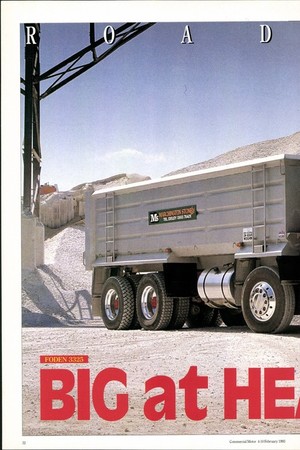
Page 35
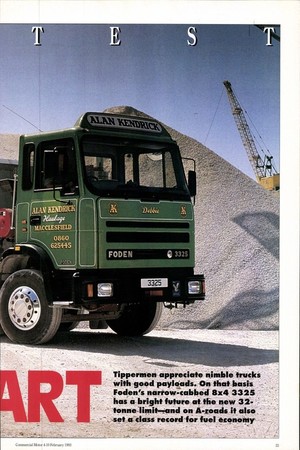
Page 36
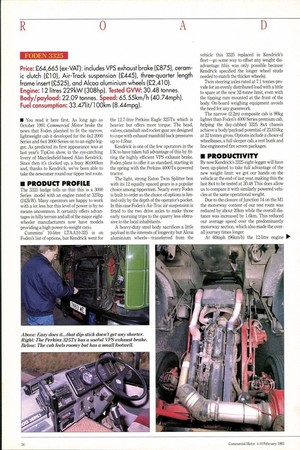
Page 38
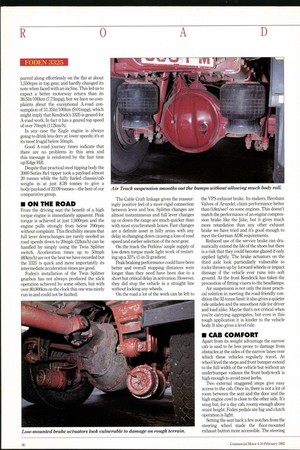
Page 39
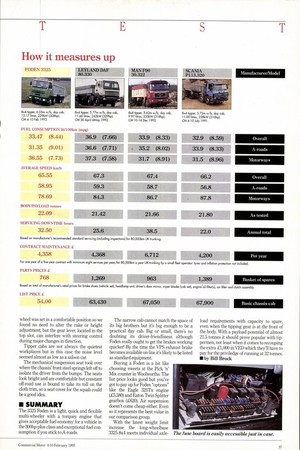
If you've noticed an error in this article please click here to report it so we can fix it.
Foden's narrow-cabbed 8x4 3325 has a bright future at the new 32tonne limit—and on A-roads it also . set a class record for fuel economy Price: £64,665 (ex-VAT): includes VPS exhaust brake (£875), ceramic clutch (£10), Air-Track suspension (£445), three-quarter length frame insert (£525), and Alcoa aluminium wheels (£2,410).
Engine: 12 litres 229kW (308hp). Tested GVVV: 30.48 tonnes. Body/payload: 22.09 tonnes. Speed: 65.55km/h (40.74mph). Fuel consumption: 33.471it/1 00km (8.44mpg).
• You read it here first. As long ago as October 1991 Commercial Motor broke the news that Foden planned to fit the narrow, lightweight cab it developed for the 4x2 2000 Series and 6x4 3000 Series on to an eight-legger. As predicted its first appearance was at last year's TipCon show, in the eye-catching livery of Macclesfield-based Alan Kendrick. Since then it's clocked up, a busy 80,000km and, thanks to Kendrick, we've been able to take the newcomer round our tipper test route.
• PRODUCT PROFILE The 3325 badge tells us that this is a 3000 Series model with an engine rated at 325hp (242kW). Many operators are happy to work with a lot less but this level of power is by no means uncommon. It certainly offers advantages in hilly terrain and all of the major eightwheeler manufacturers now have models providing a high power-to-weight ratio.
Cummins' 10-litre LTAA10-325 is on Foden's list of options, but Kendrick went for the 12.7-litre Perkins Eagle 325Tx which is heavier but offers more torque. The head, valves, camshaft and rocker gear are designed to cope with exhaust manifold back pressures up to 4.5bar.
Kendrick is one of the few operators in the UK to have taken full advantage of this by fitting the highly efficient VPS exhaust brake. Foden plans to offer it as standard, starting in the spring with the Perkins 4000Tx-powered tractor.
The light, strong Eaton Twin Splitter box with its 12 equally spaced gears is a popular choice among tippermen. Nearly every Foden is built to order so the choice of options is limited only by the depth of the operator's pocket. In this case Foden's Air-Trac air suspension is fitted to the two drive axles to make those early morning trips to the quarry less obtrusive to the local inhabitants.
A heavy-duty steel body sacrifices a little payload in the interests of longevity but Alcoa aluminium wheels—transferred from the vehicle this 3325 replaced in Kendrick's fleet—go some way to offset any weight disadvantage (this was only possible because Kendrick specified the longer wheel studs needed to match the thicker wheels).
Twin steering axles rated at 7.1 tonnes provide for an evenly distributed load with a little to spare at the new 32-tonne limit, even with the tipping ram mounted at the front of the body. On-board weighing equipment avoids the need for any guesswork.
The narrow (22m) composite cab is 90kg lighter than Foden's 4000 Series premium cab, helping the day-cabbed 3325 8x4 chassis achieve a body/payload potential of 23,610kg at 32 tonnes gross. Options include a choice of wheelbases, a full sleeper cab, a rest bunk and line engineered fire screen packages.
• PRODUCTIVITY By now Kendrick's 3325 eight-legger will have been up-plated to take full advantage of the new weight limit: we got our hands on the vehicle at the end of last year, making this the last 8x4 to be tested at 30.48 This does allow us to compare it with similarly powered vehicles at the same operational weight.
Due to the closure of Junction 14 on the M1 the motorway content of our test route was reduced by about 201un while the overall distance was increased by 1.6Iun. This reduced our average speed over the predominantly motorway section, which also made the overall journey times longer.
At 60mph (96km/h) the 12-litre engine purred along effortlessly on the flat at about 1,550rpm in top gear, and hardly changed its note when faced with an incline. This led us to expect a better motorway return than its 36.51it/1001an (7.73mpg), but we have no complaints about the exceptional A-road consumption of 31.351it/100km (9.01mpg), which might imply that Kendrick's 3325 is geared for A-road work. In fact it has a geared top speed of over 70mph (112km/h).
In any case the Eagle engine is always going to drink less dery at lower speeds; it's at its most frugal below 50mph.
Good A-road journey times indicate that there are no problems in this area and this message is reinforced by the fast time up Edge Hill.
Despite that practical steel tipping body the 3000 Series 8x4 tipper took a payload almost 20 tonnes while the fully fueled chassis/cab weighs in at just 8.39 tonnes to give a body/payload of 22.09 tonnes—the best of our comparative group.
• ON THE ROAD From the driving seat the benefit of a high torque engine is immediately apparent. Peak torque is achieved at just 1,000rpm and the engine pulls strongly from below 700rpm without complaint. This flexibility means that full lever downchanges are rarely needed as road speeds down to 20mph (321tm/h) can be handled by simply using the Twin Splitter switch. Acceleration times up to 50mph (80km/h) are not the best we have recorded but the 3325 is quick and more importantly its intermediate acceleration times are good.
Foden's installation of the Twin Splitter gearbox has not always produced the slick operation achieved by some others, but with over 80,000km on the clock this one was nicely run in and could not be faulted. The Cable Craft linkage gives the reassuringly positive feel of a more rigid connection between lever and box. Splitter changes are almost instantaneous and full lever changes up or down the range are much quicker than with most synchromesh boxes. Fast changes are a definite asset in hilly areas with any delay in changing down causing a loss of road speed and earlier selection of the next gear.
On the track the Perkins' ample supply of low-down torque made light work of restarting up a 33% (1-in-3) gradient.
Peak braking performance could have been better and overall stopping distances were longer than they need have been due to a short but critical delay in activation. However, they did stop the vehicle in a straight line without locking any wheels.
On the road a lot of the work can be left to the VPS exhaust brake. Its makers, Hersham Valves of Arundel, claim performance better than 0.8m/sec2 on some engines. This doesn't match the performance of an engine compression brake like the Jake, but it gives much more retardation than any other exhaust brake we have tried and it's good enough to meet the German ADR requirements.
Reduced use of the service brake can dramatically extend the life of the shoes but there is a risk that they could become glazed if only applied lightly. The brake actuators on the third axle look particularly vulnerable to rocks thrown up by forward wheels or impact damage if the vehicle ever runs into soft ground. At the front Kendrick has taken the precaution of fitting visors to the headlamps.
Air suspension is not only the most practical solution in meeting the road-friendly condition the 32-tonne limit it also gives a quieter ride unladen and the smoothest ride for driver and load alike. Maybe that's not critical when you're carrying aggregates, but even in this tough application it is kinder to the vehicle body. It also gives a level ride.
• CAB COMFORT Apart from its weight advantage the narrow cab is said to be less prone to damage from obstacles at the sides of the narrow lanes over which these vehicles regularly travel. At wheel level the steps and front bumper extend to the full width of the vehicle but without an underbumper valance the front bodywork is high enough to avoid most kerbs.
Two external staggered steps give easy access to the cab. Once in, there is not a lot of room between the seat and the door and the high engine cowl is close to the other side. It's snug but, for a day cab, roomy enough above waist height. Foden pedals are big and clutch operation is light.
Setting the seat back a few notches from the steering wheel made the floor-mounted exhaust button more accessible. The steering wheel was set in a comfortable position so we found no need to alter the rake or height adjustment, but the gear lever, located in the top slot, can interfere with steering control during major changes in direction.
Tipper cabs are not always the quietest workplaces but in this case the noise level seemed almost as low as a saloon car.
The mechanical suspension seat took over where the chassis' front steel springs left off to isolate the driver from the bumps. The seats look bright and are comfortable but constant off-road use is bound to take its toll on the cloth trim, so a seat cover for the squab could be a good idea.
• SUMMARY The 3325 Foden is a light, quick and flexible multi-wheeler with a torquey engine that gives acceptable fuel economy for a vehicle in the 300hp-plus class and exceptional fuel consumption if you stick to A-roads. The narrow cab cannot match the space of its big. brothers but it's big enough to be a practical day cab. Big or small, there's no doubting its driver-friendliness although Foden really ought to get the brakes working quicker! By the time the VPS exhaust brake becomes available on-line it's likely to be listed as standard equipment.
Buying a Foden is a bit like choosing sweets at the Pick 'n' Mix counter in Woolworths. The list price looks good but you've got to pay up for Foden "options" like the Eagle 325Tx engine (£5,380) and Eaton Twin Splitter gearbox (£620). Air suspension doesn't come cheap either. Even so it represents the best value in our comparison group.
With the latest weight limit increase the long-wheelbase 3325 8x4 meets individual axle load requirements with capacity to spare, even when the tipping gear is at the front of the body With a payload potential of almost 21.5 tonnes it should prove popular with tippermen, not least when it comes to recouping the extra £1,000 in VED which they'll have to pay for the priviledge of running at 32 tonnes.
• by Bill Brock
















































































